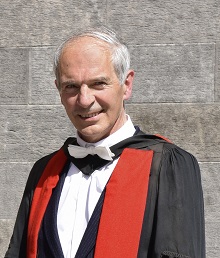Regius Chair in Maths
 Professor Kenneth Falconer has been appointed to the Regius Chair of Mathematics by Her Majesty the Queen by authority of a warrant signed by Her Majesty and the First Minister of Scotland.
Professor Kenneth Falconer has been appointed to the Regius Chair of Mathematics by Her Majesty the Queen by authority of a warrant signed by Her Majesty and the First Minister of Scotland.
One of the oldest and most prestigious chairs in the United Kingdom, the St Andrews Regius Chair was founded by Charles II in 1668 with the appointment of the celebrated mathematical pioneer James Gregory.
There are now three Regius Chairs in Mathematics, with those at Warwick and Oxford universities founded in 2013 and 2016 respectively.
Professor Falconer is a highly distinguished mathematician who has been at St Andrews since 1993 and is the University’s most senior member of senate.
He is Professor of Pure Mathematics specialising in Fractal Geometry and related matters, and is a member of the Analysis Research Group of the St Andrews School of Mathematics and Statistics.
He was an undergraduate, research student and Research Fellow at Corpus Christi College, Cambridge, and became a Lecturer and then a Reader at the University of Bristol before moving to St Andrews in 1993.
He has been a Visiting Professor at a number of universities including Oregon State University and the Australian National University, Canberra, as well as at the Isaac Newton Institute on several occasions.
Kenneth’s main research interests are in fractal and multifractal geometry, geometric measure theory and related areas. His wide-ranging research has involved the description, occurrence, geometrical properties and dimensional analysis of fractal sets and measures.
For example, his work on projections of fractals led to the concept of the digital sundial (a set with essentially any desired projections in all directions).
He has derived formulae for the dimensions of specific types of fractals and multifractals such as self-affine sets and non-conformal repellers in dynamical systems.
He has worked on dimensional and topological properties of random fractals and multifractals, including fractal percolation problems. He has recently studied nonlinear partial differential equations on fractal domains and random fractal processes.
Kenneth’s other research interests also have a geometric flavour: these include the geometry of convex sets, combinatorial geometry and the mathematics of X-ray tomography. His book, Unsolved Problems in Geometry, written with Hallard Croft and Richard Guy, surveys unsolved problems in these and other areas of geometry, though many of the problems discussed are no longer ‘unsolved’.
In his youth Kenneth worked at the National Physical Laboratory for a short time, where he wrote an automatic contouring algorithm which was incorporated into the NAG Library.
He has published widely with over 100 papers to his name in mathematics journals, and authored the best-selling books Fractal Geometry – Mathematical Foundations and Applications (with Solutions Manual 2nd Ed. Solutions Manual 3rd Ed.), Techniques in Fractal Geometry and The Geometry of Fractal Sets.
His most recent book, Fractals – A Very Short Introduction, presents the ideas of fractals at a very basic level.
Issued by the University of St Andrews Communications Office, contactable on 01334 46 2530 or [email protected].
Category University news